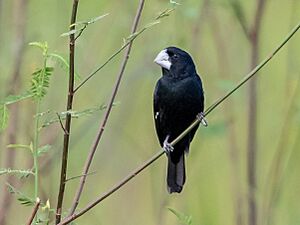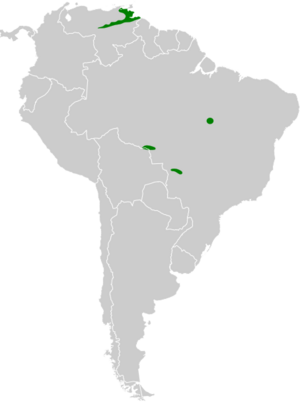Great-billed seed finch facts for kids
Quick facts for kids Great-billed seed finch |
|
|---|---|
 |
|
| male | |
| Conservation status | |
| Scientific classification | |
| Genus: |
Sporophila
|
| Species: |
maximiliani
|
 |
|
| Synonyms | |
|
Oryzoborus maximiliani |
|
The Great-billed seed finch (Sporophila maximiliani) is a small, special bird found in parts of South America. It belongs to the Thraupidae family, which includes many types of tanagers and finches. These birds are known for their very large, thick bills, which help them eat seeds.
Great-billed seed finches live in wet places like swamps and bushy areas, especially where it floods. You can find them in two main areas: the northern Amazon rainforest and a grassy region called the Cerrado. Males are mostly black with white under their wings, and they have a cool ivory-white bill. Females are light brown with black bills. Both have a beautiful, musical song, which unfortunately makes them a target for people who trap birds.
Sadly, the number of Great-billed seed finches is going down quickly. This is because of trapping and losing their homes. Scientists are still learning a lot about how these birds live and behave.
Contents
Bird Names and Groups
This bird has had a few different names over time! In 1815, a female Great-billed seed finch was found in Brazil. It was first called Fringilla crassirostris. Later, in 1851, a scientist named Jean Cabanis placed it in a new group called Oryzoborus.
For a while, the Great-billed seed finch and five other similar birds were all in the Oryzoborus group. These birds were:
- the chestnut-bellied seed finch
- the large-billed seed finch
- the black-billed seed finch
- the thick-billed seed finch
- the Nicaraguan seed finch
It was often hard to tell the female seed finches apart because they looked very similar. So, scientists mostly used the male birds' colors to sort them into groups. But after more studies, including looking at their genes, scientists decided that the Oryzoborus group should be combined with another group called Sporophila. Now, the Great-billed seed finch is part of the Sporophila genus.
There are also two slightly different types, or subspecies, of the Great-billed seed finch:
- S. m. maximiliani: This type is found mainly in the Cerrado region of Brazil and eastern Bolivia.
- S. m. parkesi: This type lives in northern South America, including parts of Venezuela and Guyana.
What They Look Like
Great-billed seed finches are about 14.5 to 16.5 centimeters (about 6 inches) long. They show strong differences between males and females, which is called sexual dimorphism.
- Males: They are mostly black with white or black and white feathers under their wings. Their very large, thick bill is a chalky white color.
- Females: They have a warm brown back and a lighter brown belly. They also have white feathers under their wings. Their bill is black.
Both males and females have a really big, thick bill. It's so big that its volume is about 840 cubic millimeters! Young birds look similar to the females. As male juveniles grow up, they start to sing, and their feathers slowly change from brown to black. This can make them look patchy for a few months.
Because they look similar to other bird species, and because males, females, and young birds look different, it can be tricky to identify Great-billed seed finches just by looking at them.
The eggs of the Great-billed seed finch are grayish-white. They have black blotches and light brown spots.
Where They Live
The Great-billed seed finch lives in two separate areas in South America. The southern group lives in the Cerrado region of Brazil. The northern group lives in the northern part of the Amazon rainforest.
These birds love wet places. You'll often find them near flooded areas and the edges of marshes.
How They Live
What They Eat
The Great-billed seed finch mainly eats seeds. They especially like the seeds from many types of Cyperaceae plants, which are like grasses or sedges. These birds are usually seen in pairs. Scientists are still learning more about their eating habits.
Reproduction and Life Cycle
The breeding season for Great-billed seed finches usually starts around November or December in central and southern Brazil. It lasts until late February or early March. The first heavy rains of spring encourage them to breed. These rains help the Cyperaceae plants grow and produce seeds, which are ready when the birds need them.
During breeding season, these finches can be very protective of their territory. Their nests are shaped like a cup and are built anywhere from one to three meters (about 3 to 10 feet) off the ground. Females lay two or three eggs in a clutch, and the female bird incubates them.
Why They Need Our Help
The Great-billed seed finch, along with two other large seed finches, has faced a big drop in its population. This is mainly because people trap them. They are highly sought after for their beautiful, musical song.
These birds are also losing their homes. The natural grasslands where they build their nests are being turned into farms. Fires started by humans for farming and raising cattle also harm their habitat. Even pesticides sprayed from the air can affect the bird population.
Their Status
The Great-billed seed finch is considered rare to uncommon. Its population size is decreasing. Scientists estimate there are only about 1,000 to 2,499 individual birds left. Because of this, the International Union for Conservation of Nature (IUCN) has listed this species as globally endangered.
Images for kids



